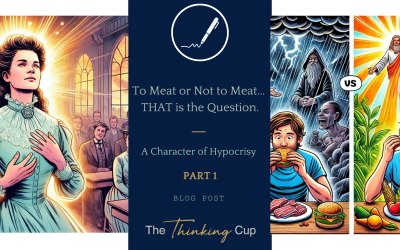A common misconception in the Christian mind, and almost always in the Adventist framework, is the understanding that because the Ten Commandments were written on stone, therefore they are deemed important in the permanence and durability of the Decalogue. When viewed in this context, one creates an unnecessary contrast between what was written on stone with the finger of God (we covered this part in my last post) and what was written on vellum. This contrast creates a logical fallacy as to the eternality of the law and shows up in statements from their commentary on the Law.
Francis D. Nichols from the Seventh-day Adventist Bible Commentary Vol. 1 asserts:
“The fact that the Ten Commandments were written on two tables of stone emphasizes their application to two classes of moral obligation: duty to God and duty to man (Matt. 22:34–40).” [1]
“…It provided commandments written on stone and “judgments” written in a book…” [2]
Even though Adventists belabor the point that these ‘stone’ commandments should be interpreted as moral laws etched in stone and must be observed since they are written in stone for all. Just because one claims something to be fact doesn’t make it so. The stone tablets on which the Ten Commandments were written do not indicate permanence and durability. One can quickly notice from the text that Moses broke the first stone tablets upon coming down the mountain. (Exodus 32:19)
Stone was one of several surfaces that could be written on in the Ancient Near East. The culture of the Exodus period didn’t have digital tablets or reams of paper at the local Office Max. They only had a few surface types that could be used for writing. Stone was the writing surface that would last the longest. It is important to remember that the Law on Mount Sinai was given after they had spent decades in Egyptian culture.
André Lemaire points out in his entry on Writing and Writing Materials:
“Many Egyptian texts were engraved in rock or stone so that they would be preserved, and many of these can still be read after nearly 5000 years.” [3]
It doesn’t take much to understand why Moses would have used stone to engrave the commands given by Yahweh when the location was on top of a rock mountain. There is no indication from the text that Moses knew before ascending the mountain that he was to bring writing equipment. Moses would have been expected to utilize the materials at the top of the mountain.
André goes on to say,
“Virtually any surface can be used as a medium for writing an inscription: one has only to use tools appropriate to the surface. However, certain writing surfaces with their appropriate instruments are more commonly attested than others, and this is especially true in ancient Israel in connection with the writing of biblical texts.
Stone can be used as a writing surface either for monumental inscriptions or for graffiti. Monumental inscriptions on stone, often associated with reliefs, are well-attested in Anatolia, North Syria, Persia, Phoenicia, and Egypt. In ancient Israel, several monumental inscriptions were engraved on stone in Jerusalem, among them the famous Siloam inscription and several tomb inscriptions cut into the East slope of the Kidron valley.” [4]
The Ten Commandments were also written in the Book of the Law in the same way they were engraved on stone. (Deut. 30:10) Ironically, the copy of the Ten Commandments in the Book of the Law outlasted the stone set. This copy was what was placed on the side of the Ark of the Covenant before Moses passed away.
“When Moses had finished writing the words of this law in a book to the very end, Moses commanded the Levites who carried the ark of the covenant of the Lord, ‘Take this Book of the Law and put it by the side of the ark of the covenant of the Lord your God, that it may be there for a witness against you.’” (Dt 31:24–26)
This copy of the Commands of God, found in the Book of the Law and preserved for us in Exodus 20 and Deut 5, is what we now consider the Commandments. The original stone tablets with the Ten Words engraved on them have never been found.
John Durham I., in his commentary on Exodus, makes an interesting observation:
“The tablets of stone Yahweh promises to give to Moses are the tablets written on both sides (Exod 32:15), the tablets Moses is subsequently to break in his anger at the people’s idolatry (32:19). Precisely what was written on them is nowhere said in the OT, not even here where Yahweh owns having done the writing. Tradition has assumed that the original stone tablets bore the Ten Commandments largely because of Exod 34:1, in which Yahweh proposes to write on the second pair of tablets “the words that were on the first tablets,” and because of 34:27–28, in which Yahweh dictates to Moses, who writes on the tablets “the words of the covenant, the ten words” (דברי הדרית עשׂרת הדברי). The OT references, however, are not consistent, as even these passages in Exodus 24 and 34 show, and the phrase in v 12, “the tablets of stone and the instruction and the commandment I have written to direct the people,” does not clear up the difficulty. While the tradition that the tablets contained the Ten Commandments may be seen to have been started very early and must for that reason alone be taken seriously, this first and possibly earliest reference to the contents of the tablets is ambiguous.” [5]
So, we genuinely do not know precisely what was on those stone tablets. The portions of scripture that discuss what we call today the Decalogue are NOT the stone tablets. From the Babylonian Captivity to 605 B.C., the Ark of the Covenant had been lost and was never found. Adventists and all of Christiandum are only aware of the Ten Commandments because of the Book of the Law. And that Book of the Law, not the stone tablets, has survived to this day. To think that they are the same would be absurd.
The fact that the account in Exodus 20 of the giving of the Law to Moses states that it was on stone tablets does not mean or insinuate permanence or durability. An interesting side note: According to Deut. 27:1-4 and Joshua 8:30-32, the entire Book of the Law of Moses was written on stone. Adventists call this very law “ceremonial law” that was subsequently abolished at the Cross of Christ. [6] (As asserted in the Fundamental Beliefs)
Ekkehardt Mueller and Eike Mueller make the following claim:
“…it is perplexing that some would entertain the idea that Deuteronomy 31:24–26 alludes to the Mosaic ceremonial law only, at the exclusion of the Ten Commandments. The expressions “the words of this law” (cf. Deut 17:19; 27:3, 8, 26; 28:58; 29:29; 31:12; 32:46) and “Book of the Law [of Moses]” (Deut 28:61; 29:21[29:20, MT], 30:10; cf. Josh 1:8; 8:31, 34; 23:6; 24:26; 2 Kgs 14:6; Neh 8:1, 3, 8; 9:3) refer to the book of Deuteronomy as a whole or more specifically to chs. 5–26 (or 5–28), which is the central (covenant) section of the book and of which the first part is exactly the Ten Commandments (Deut 5:1–22).” [7]
Adventists state emphatically that the ceremonial laws were the laws that were nailed to the cross, but the moral laws (Ten Commandments) are eternal and binding on all humanity. As we saw in the quote above, the law written on the Tablets was both ceremonial and moral, if one can even use these distinctions. It is logical to conclude that if stone indicates permanence, as they argue, then the very law they claim to be ceremonial and abolished is actually permanent. And they are bound to keep all of it because it, too, was “written on stone.”
The truth is that this issue has been ongoing since the early years of Adventism, and ever since, it has become a part of the very fabric of the Adventist system and its supposed uniqueness. James White and Hiram Edson, early Adventist pioneers, wrote these thoughts:
“I design to show that there is a perfect harmony in all the Scripture testimony of both Testaments, in relation to the observance of the Holy Sabbath. The fourth commandment in the Decalogue is the great Sabbath law. It is the standard to which all other Scripture testimony relating to the Sabbath should be brought, and carefully compared. [8]
I know that some say that we cannot keep the Sabbath, as it is given in the Old Testament; but this is like most of the false assertions made by those who oppose the true Sabbath. I am not ready to admit that God has given us a law, that we cannot keep. I dare not charge him with such injustice. The commandments of our holy and just God, are not grievous, but joyous to those who keep them. those who followed Jesus from Galilee, saw his body put in Joseph’s new tomb, then returned “and rested on the Sabbath according to the COMMANDMENT [emphasis added].” See Luke 23:54–56. They could keep the Sabbath according to the law of God, after the ceremonial law was abolished, and so can we.” [9]
These thoughts from Hiram Edson and James White shed light on the view through which they began to filter the importance of the Adventist movement and interpret scripture through. Ellen White, who had previously claimed that God told her that the coming of Jesus would be in 1843 and 1844, would begin to speak on this matter on March 24th, 1849. Remember that Ellen would make one more false claim that Jesus would come again in 1851. At that point, she went silent on her false date setting. Ellen claimed the following:
“Sabbath, March 24th, 1849, we had a sweet, and very interesting meeting with the Brethren at Topsham, Me. The Holy Ghost was poured out upon us, and I was taken off in the Spirit to the City of the living God. There I was shown that the commandments of God, and the testimony of Jesus Christ, relating to the shut door, could not be separated, and that the time for the commandments of God to shine out, with all their importance, and for God’s people to be tried on the Sabbath truth, was when the door was opened in the Most Holy Place of the Heavenly Sanctuary, where the Ark is, containing the ten commandments. This door was not opened, until the mediation of Jesus was finished in the Holy Place of the Sanctuary in 1844. Then, Jesus rose up, and shut the door in the Holy Place, and opened the door in the Most Holy, and passed within the second vail, where he now stands by the Ark; and where the faith of Israel now reaches.
I saw that Jesus had shut the door in the Holy Place, and no man can open it; and that he had opened the door in the Most Holy, and no man can shut it: (See Rev. 3:7, 8:) and that since Jesus has opened the door in the Most Holy Place, which contains the Ark, the commandments have been shining out to God’s people, and they are being tested on the Sabbath question.
I saw that the present test on the Sabbath could not come, until the mediation of Jesus in the Holy Place was finished; and he had passed within the second vail; therefore, Christians, who fell asleep before the door was opened in the Most Holy, when the midnight cry was finished, at the seventh month 1844; and had not kept the true Sabbath, now rest in hope; for they had not the light, and the test on the Sabbath, which we now have, since that door was opened. I saw that Satan was tempting some of God’s people on this point. Because so many good Christians have fallen asleep in the triumphs of faith, and have not kept the true Sabbath, they were doubting about it being a test for us now.
I saw that the enemies of the present truth have been trying to open the door of the Holy Place, that Jesus has shut; and to close the door of the Most Holy Place, which he opened in 1844, where the Ark is containing the two tables of stone, on which are written the ten commandments, by the finger of Jehovah.” [10]
Ellen White is the one who begins to form and make de facto statements from God. Her assertions aren’t Biblically based; they are just stated as God claimed. We know now that her date setting was wrong and the mark of a false prophet. Why Adventists won’t admit this, I genuinely do not know. But to think that the other ideas and items of importance claimed by Ellen during these times would be accurate and above testing is just foolish.
In my next post, we will discuss whether the Old Testament laws should be divided into ceremonial and moral laws and then claim that the ceremonial laws were nailed to the cross, not the moral laws.
[1] Francis D. Nichol, ed., The Seventh-Day Adventist Bible Commentary, vol. 1 (Review and Herald Publishing Association, 1978), 601.
[2] Francis D. Nichol, ed., The Seventh-Day Adventist Bible Commentary, vol. 1 (Review and Herald Publishing Association, 1978), 631.
[3] André Lemaire, “Writing and Writing Materials,” in The Anchor Yale Bible Dictionary, ed. David Noel Freedman (New York: Doubleday, 1992), 999.
[4] André Lemaire, “Writing and Writing Materials,” in The Anchor Yale Bible Dictionary, ed. David Noel Freedman (New York: Doubleday, 1992), 1001.
[5] John I. Durham, Exodus, vol. 3, Word Biblical Commentary (Dallas: Word, Incorporated, 1987), 345–346.
[6] “Seventh-Day Adventists Believe.”, pg. 274
[7] Ekkehardt Mueller and Eike Mueller, eds., The Sabbath in the New Testament and in Theology: Implications for Christians in the Twenty-First Century, vol. 2, Biblical Research Institute Studies on the Biblical Sabbath (Silver Spring, MD: Biblical Research Institute, 2023).
[8] James White and Hiram Edson, Facsimile Reproductions of The Present Truth and The Advent Review, vol. 1, Early S. D. A. Periodicals (Washington, DC: Review and Herald Publishing Association, 1946), 13.
[9] James White and Hiram Edson, Facsimile Reproductions of The Present Truth and The Advent Review, vol. 1, Early S. D. A. Periodicals (Washington, DC: Review and Herald Publishing Association, 1946), 13–14.
[10] James White and Hiram Edson, Facsimile Reproductions of The Present Truth and The Advent Review, vol. 1, Early S. D. A. Periodicals (Washington, DC: Review and Herald Publishing Association, 1946), 21.
[11] John M’Clintock and James Strong, “Books,” in Cyclopædia of Biblical, Theological, and Ecclesiastical Literature, Supplement—A–Z (New York: Harper & Brothers, Publishers, 1894), 560.




0 Comments